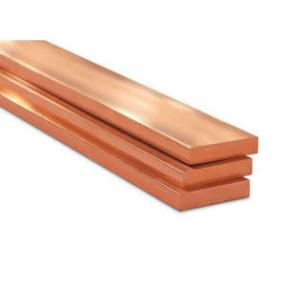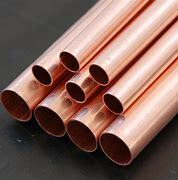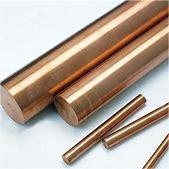1. Introduction
Copper prices surged over the past 48 hours following supply chain disruptions in Chile—the world’s largest copper producer—due to unexpected mine closures and labor strikes. As of June 2024, LME copper spot prices jumped nearly 4%, directly impacting the cost of copper rod, strips, pipes, and bars worldwide. This volatility makes understanding copper products more critical than ever for contractors, electricians, recyclers, and DIY enthusiasts.

Whether you’re installing an earthing system, welding copper components, or plumbing an air conditioning unit, knowing the right type of copper product—be it a copper rod, copper strip, or copper pipe—is essential for performance, safety, and cost-efficiency.
2. What Is a Copper Rod?
A copper rod is a solid cylindrical bar made of high-conductivity copper, commonly used in electrical grounding, welding, and industrial manufacturing. Depending on the application, you might encounter terms like rod copper, copper round bar, or round bar copper—all referring to the same basic form but sometimes differing in purity or temper.
Copper rods are available in various diameters and lengths, and their composition can range from pure electrolytic-tough-pitch (ETP) copper to copper alloys like beryllium copper for specialized mechanical properties.
3. Types and Uses of Copper Rods
3.1 Earthing and Grounding Applications
For electrical safety, copper earth rods—also called earthing rod copper or ground rod copper—are driven into the soil to dissipate fault currents. Popular options include copper bonded earthing rods and copper clad steel earth rods. These combine the conductivity of copper with the strength of steel, offering durability at a lower cost than solid copper.
When comparing earthing rod price points, copper bonded ground rods and copper clad ground rods are often more economical than solid copper, while still meeting international standards like IEEE 80.
3.2 Welding and Brazing
In metal joining, copper brazing rod and copper welding rod are essential. Copper to copper brazing rods and copper to copper welding rod types are specifically formulated to fuse copper components without cracking. Copper rod for welding is typically used in TIG or oxy-acetylene processes, especially in HVAC and refrigeration work.
Note: welding rod copper must match the base metal’s composition to avoid weak joints or corrosion.

4. Copper Strips: Flexible Conductors for Diverse Needs
Flat and thin, copper strips—sometimes called copper stip, copper stripes, or copperstrip—are used in busbars, earthing systems, and even decorative applications like copper roof strip or copper tape for snails (a gardening hack to deter pests).
Common variants include:
- Flat copper strip and thin copper strips for electrical panels
- Beryllium copper strip and copper beryllium strip for springs and connectors
- Nickel plated copper strip for enhanced corrosion resistance
- Copper strip for earthing, often sized 25x3mm (copper earth strip 25x3mm price varies by region and purity)
For recyclers, questions like ‘best way to strip copper wire’ or ‘fast way to strip copper wire’ are common. However, burning copper wire for scrap is dangerous and illegal in many areas—mechanical stripping or using a wire stripper is safer and preserves copper value.
If you’re sourcing materials, you might search ‘copper strip near me’ or ‘roll of copper strip’ for bulk purchases. Prices fluctuate with the market—copper strip price is often quoted per kg or per meter.
5. Copper Pipes and Tubing in Plumbing and HVAC
Copper pipework remains a gold standard in plumbing and air conditioning systems. Aircon copper pipe (also called air conditioning copper pipe or AC copper pipe) is prized for its thermal conductivity and corrosion resistance.
Common sizes include 15mm copper pipe, 22mm copper tube, and 3/4 copper tubing. Proper copper pipe sizing ensures efficient refrigerant flow in AC units.
Installation tips:
- Always clean copper pipe before soldering
- Use copper pipe fittings and copper tubing fittings rated for the application
- Avoid mixing with PEX plumbing pipes unless using proper transition fittings

Resoldering copper pipe joints is possible without full disassembly, but requires thorough cleaning and flux application. Bending copper pipe should be done with a spring or tube bender to prevent kinking.
Current AC copper pipe price trends reflect the broader copper market surge, so locking in rates early can save costs on large HVAC projects.
6. Copper Bars and Ingots: Powering Electrical Infrastructure
Beyond rods and strips, copper bars—including copper bus bar, flexible copper bus bar, and copper flat bar—are vital in power distribution. Cu bars handle high currents in switchgear, transformers, and battery systems.
Copper ingot price directly affects fabricated products like copper bars for sale. While melting scrap into copper ingot might seem profitable, refining costs and purity standards often make it impractical for small-scale operators.
For hobbyists or small workshops, questions like ‘how to make copper bars’ usually refer to casting—but commercial-grade conductivity requires industrial refining.
7. Recycling and Scrap Considerations
Stripping copper wire for scrap remains a popular side hustle. The best way to strip copper cable involves using automatic wire strippers or manual tools—never burn insulation, as it releases toxic fumes and degrades copper quality.
Stripping wire for recycling not only earns cash but supports sustainability. Always check local regulations before processing scrap.
8. Conclusion
From copper rod for earthing to aircon copper tube for cooling systems, copper’s versatility makes it indispensable across industries. With recent price hikes, choosing the right type—whether solid, copper bonded, or copper clad steel—can balance performance and budget. Whether you’re a professional or a DIYer, understanding these copper products ensures safer, more efficient, and cost-effective projects.
Our Website founded on October 17, 2012, is a high-tech enterprise committed to the research and development, production, processing, sales and technical services of ceramic relative materials such as Understand. Our products includes but not limited to Boron Carbide Ceramic Products, Boron Nitride Ceramic Products, Silicon Carbide Ceramic Products, Silicon Nitride Ceramic Products, Zirconium Dioxide Ceramic Products, etc. If you are interested, please feel free to contact us.

